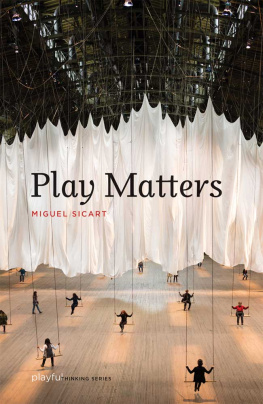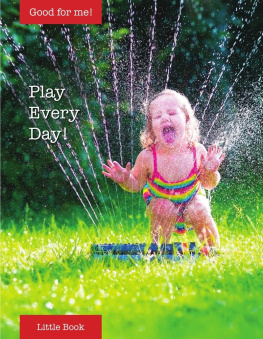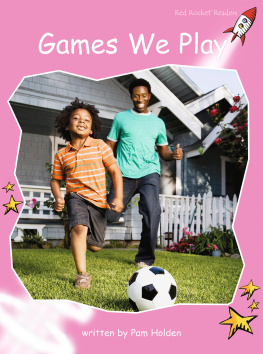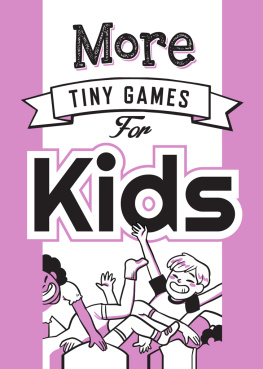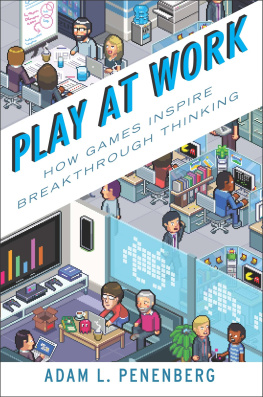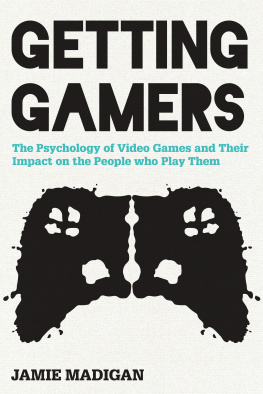Play Matters
Playful Thinking
Jesper Juul, Geoffrey Long, and William Uricchio, editors
The Art of Failure: An Essay on the Pain of Playing Video Games, Jesper Juul, 2013
Uncertainty in Games, Greg Costikyan, 2013
Play Matters, Miguel Sicart, 2014
Play Matters
Miguel Sicart
The MIT Press
Cambridge, Massachusetts
London, England
2014 Massachusetts Institute of Technology
All rights reserved. No part of this book may be reproduced in any form by any electronic or mechanical means (including photocopying, recording, or information storage and retrieval) without permission in writing from the publisher.
Library of Congress Cataloging-in-Publication Data
Sicart, Miguel, 1978
Play matters / Miguel Sicart.
p. cm. (Playful thinking)
Includes bibliographical references and index.
ISBN 978-0-262-02792-2 (hardcover : alk. paper)
ISBN 978-0-262-32596-7 (retail e-book)
1. PlayPsychological aspects. I. Title.
BF717.S49 2014
155dc23
2014003660
On Thinking Playfully
Many people (we series editors included) find video games exhilarating, but it can be just as interesting to ponder why that is so. What do video games do? What can they be used for? How do they work? How do they relate to the rest of the world? Why is play both so important and so powerful?
Playful Thinking is a series of short, readable, and argumentative books that share some playfulness and excitement with the games that they are about. Each book in the series is small enough to fit in a backpack or coat pocket, and combines depth with readability for any reader interested in playing more thoughtfully or thinking more playfully. This includes, but is by no means limited to, academics, game makers, and curious players.
So, we are casting our net wide. Each book in our series provides a blend of new insights and interesting arguments with overviews of knowledge from game studies and other areas. You will see this reflected not just in the range of titles in our series, but in the range of authors creating them. Our basic assumption is simple: video games are such a flourishing medium that any new perspective on them is likely to show us something unseen or forgotten, including those from such unconventional voices as artists, philosophers, or specialists in other industries or fields of study. These books are bridge builders, cross-pollinating both areas with new knowledge and new ways of thinking.
At its heart, this is what Playful Thinking is all about: new ways of thinking about games and new ways of using games to think about the rest of the world.
Jesper Juul
Geoffrey Long
William Uricchio
Acknowledgments
This book has given me the excuse to meet, work with, learn from, and teach many great people. First of all, it has given me the opportunity to work again with Doug Sery and the MIT Press crew, always a pleasure. The editors of the Playful Thinking series, Jesper Juul, Geoffrey Long, and especially William Uricchio, were of invaluable help in shaping this book. I am also indebted to the anonymous reviewers who helped me improve the book in critical ways.
This book was inspired by and owes much to TL Taylor and Doug Wilson. Gonzalo Frasca, Bart Simon, Jaako Stenros, and Olli Leino have been sources of inspirationand of challenges too.
The structure of the book crystallized when I was teaching a design course in playful interaction at the IT University of Copenhagen in 2011. I am thankful for my students patience.
I thank as well the organizers of the Copenhagen Play Festival (w00t.dk), especially Thomas Vigild and the Copenhagen Game Collective, who gave me the opportunity to present a short version of this book during the 2013 festival.
Play Matters benefited from a number of readers who helped with the early drafts of this text: you know who you are and how much I appreciate your help. Sebastian Deterding and Sebastian Mring especially contributed with productive criticism and insights.
Finally, Ane provides help, support, and a smile when I most need it.
This book is for Carlos and Silas, makers of chaos and order in play.
Instructions for Reading This Book
Look at the number of notes in this book.
There are hundreds of them. (Yes, you read right.) But dont despair. You can read Play Matters without reading any of the notes. They will be there, waiting for youperhaps even haunting you. But you do not need to read them.
If you want to know more about play and why it matters, go ahead and read the text. Ignore the notes until you find an idea that provokes you or puzzles you or is a concept you want to know more about. The notes are there to expand the book and give you other ideas, other perspectives, other challenges.
The notes are an extension of the book, and so is the books website, playmatters.cc. Use them to explore beyond the bounds of this book why play matters.
1 Play Is
Think about play, and what it means to you.
What comes to mind? A pastime? Games? Childhood activities? The opposite of work? A source for learning? What youd rather be doing now?
Think again: How much do you know about play?
Lets start with a simple exercise. List your daily activities, the tasks that structure your day, from work to leisure to those things you have to do that are neither, yet you have to do them.
How do you do these tasks? If you are happy and well rested, you may approach your day in a playful way, enjoying what you do. Happiness may give you time to play, to live in a different way. The temptation of enjoying and living life through play, of having fun, is always present.
To play is to be in the world. Playing is a form of understanding what surrounds us and who we are, and a way of engaging with others. Play is a mode of being human.
We live in exciting times. You might have encountered the argument that games are now everywhere
I disagree, to a certain extent. Games dont matter. Like in the old fable, we are the fools looking at the finger when someone points at the moon. Games are the finger; play is the moon.
What is true is that play is a dominant way of expression in our First World societies. We play games, but also with toys, on playgrounds, with technologies and design. And play is not just the ludic, harmless, encapsulated, and positive activity that philosophers have described. Like any other form of being, play can be dangerous; it can be hurting, damaging, antisocial, corrupting. Play is a manifestation of humanity, used for expressing and being in the world.
To understand what play is, I propose here a portable theory, or rhetoric, of play. Instead of deriving an understanding of play from a particular object or activity, like war, ritual, or games, I see play as a portable tool for being. It is not tied to objects but brought by people to the complex interrelations with and between things that form daily life.
Why propose a theory of play now? In our culture, playful has become a positive word. The author of the 2011 biography of Steve Jobs uses playful as a word of praise for the design of Apple computers, originally conceived to contrast with dull corporate machines. Apples playful design appropriated cues from an understanding of play as a personal expression: beauty, countercultural politics, and moral values. That is the value and place of play in our culture.
Despite its importance, we are still trying to understand play with models inherited from the past. Our theories are mostly derived from the work of Dutch cultural historian Johan Huizinga, who famously coined the concept of Homo Ludens. This book is not written in the tradition of Huizingan play, understood as a fair contest that creates a separate world with rules that are never questioned. The nature of play I am advocating for here is different from that of Huizinga.
Next page
